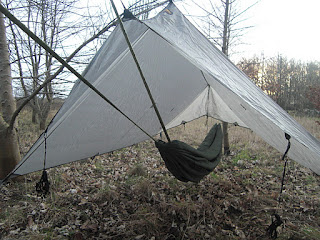This tent is made by
Terra Nova and is virtually identical in looks and design to the Terra Nova Laser Competition. I approached them asking if I might borrow a Zephyros 1 for review and they were happy to oblige. According to the Terra Nova web site, the Laser Competition weighs 930 grams; the Zephyros weighs 1,570 grams. The difference is in the materials. The Zephyros fly is made of Pu Polyester which is light but not as light as the Laser's silnylon. There is also a price difference. The Zephyros is £149 compared to the Laser which retails at £320.
The tent comes in a bag with a measured length of 52cm x 14cm. On unpacking it and thinking it might be rolled up to a shorter length, my immediate thought was that this might not be possible because of the two struts at either end of the fly (but see later).
The single shock-corded pole and pegs are in separate bags. There is also a pole sleeve, a short length of tube for carrying out temporary repairs to the pole. The brief instructions are on a flap stitched inside the tent bag. The inner comes ready attached to the fly with toggles.
Now my impressions on setting it up for the first time. It is actually very easy. The fly and inner are laid down flat. The instructions don't actually say so, but it makes sense to lay them down with the fly uppermost. The pole is then assembled and passed through the sleeve on the fly and the ends of the pole placed in the brass rings on either side. There are two rings on each side and I suppose it is optional which rings to use depending on how easy it is to insert the pole ends but I found the outer rings easier.
The tapes either end of the inner are then pegged down, followed by the guys at either end of the fly. The instructions then say to peg down the remaining loops attached to the inner and fly. I proceeded to do so but then found that I seemed to have insufficient pegs until I realised that at each point the inner and fly share a peg.
The side guys are then pegged out. I dismantled it and started again. This time around it was up in seconds. Very good indeed.
The floor attached to the inner is very thin. Wild Country will supply a footprint as an optional extra. I certainly think something is needed to protect the floor.
I could sit up in it quite comfortably, the highest point being in the middle under the hoop. However, I'm only 5ft 6in. Perhaps taller people are used to restricted headroom but it depends very much on the length of the individual's trunk.
The pegs are adequate but tended to have sharp edges which would be unpleasant particularly when being taken out of the ground on cold mornings. They are not very comfortable to use. They are V sectioned and I think would be effective in most conditions.
The tent was tested over a weekend in the Peak District in wet and very windy conditions. It performed very well and felt secure. There is ample room for one person. I found that I was able to store most of my gear inside with me quite comfortably with cooking equipment and boots in the porch. The porch size is quite adequate for cooking using extreme care although Wild Country do not recommend it. An inside pocket for spectacles, valuables, etc. would be a useful addition with no weight penalty.
On packing it away, I found that the two end struts were better stored in the pole bag. This meant that the tent packed to a smaller size. I have a gripe about the plastic boots on each end of the struts. They would benefit from being bonded to the struts. They tended to be left in the little pockets attached to the inner. At worst, they could easily be lost.
For - price, comparatively light weight, space, easy to put up.
Against - pegs.
All in all, a superb tent for anyone on a limited budget. I liked it very much.










